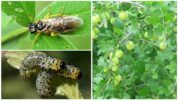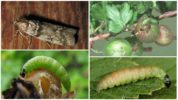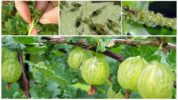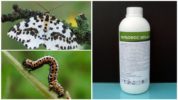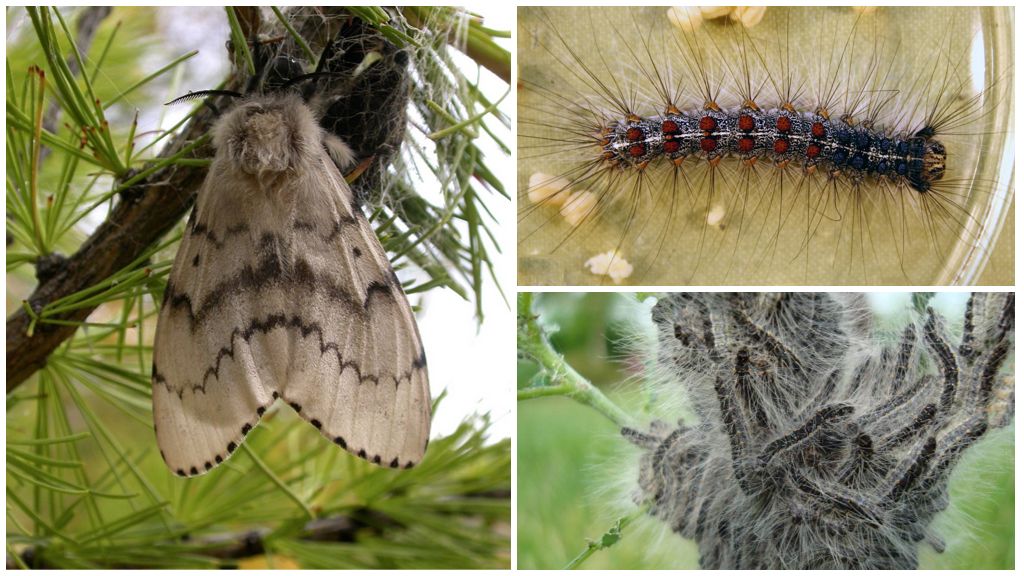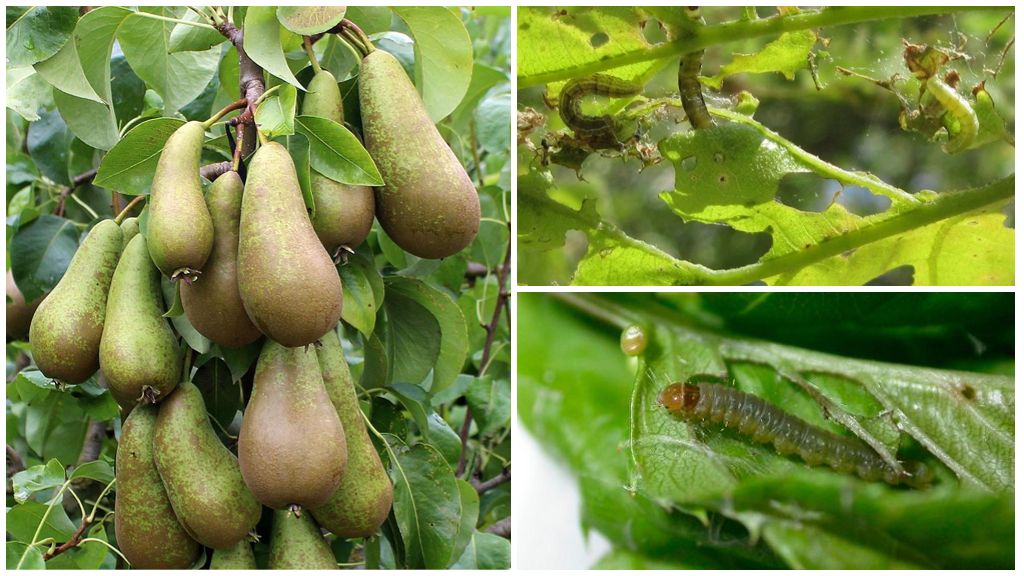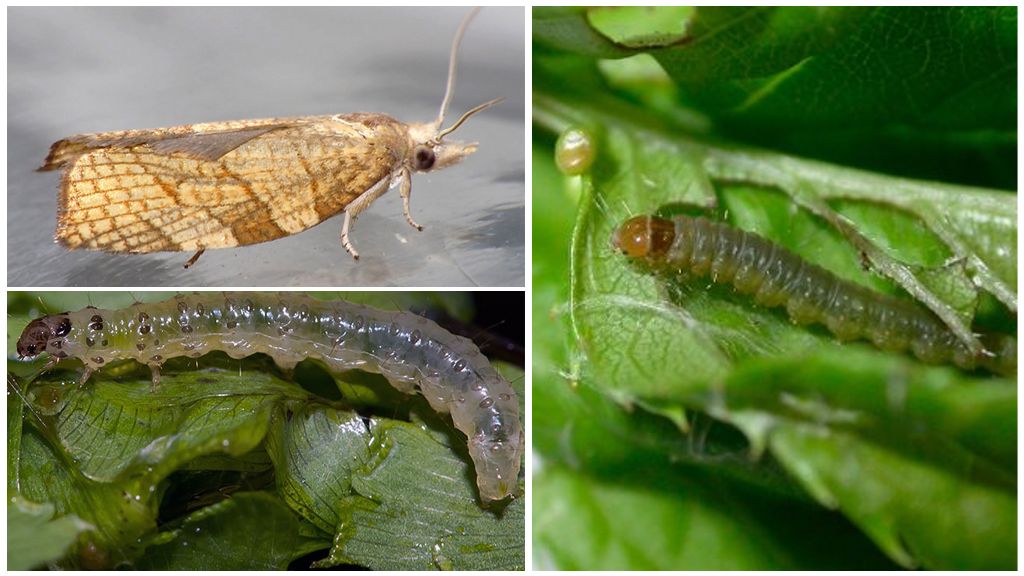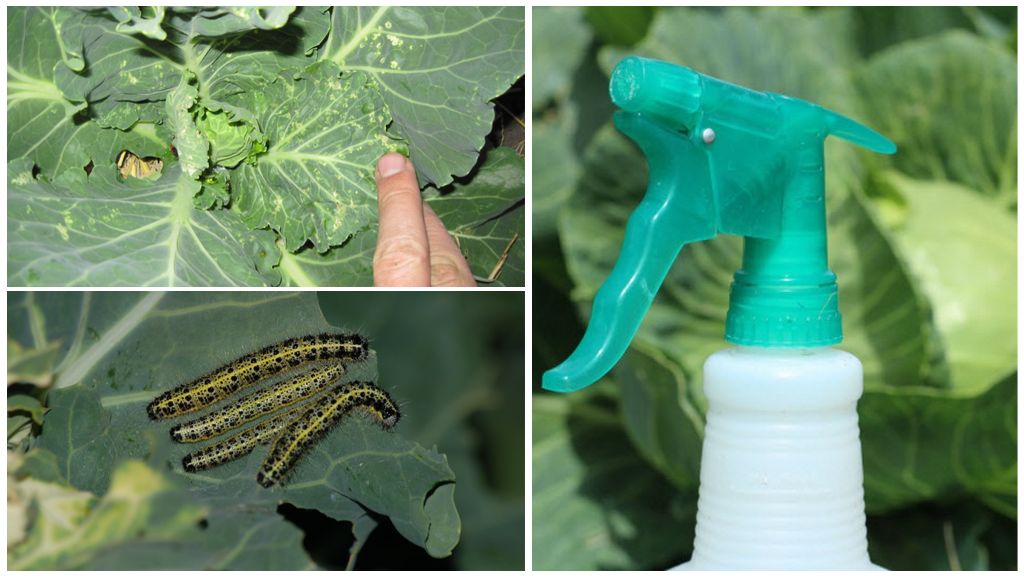- Gooseberry sawfly
- Gooseberry moth
- Gooseberry aphid
- Moth
From the first days of spring, not only nature comes to life. Various types of pests are showing their activity, which have been waiting for the winter, burrowing deep in the soil or hiding under the fallen leaves. Looking for food hungry caterpillars attack plants that started to wake up, thereby causing great damage to garden trees and shrubs. Shrub - gooseberry suffers greatly from them. As a result of damage to the stems and leaves of the plant, the yield is reduced. For this reason, many gardeners, summer residents are worried about how to deal with gooseberry caterpillars. To get an answer to this question, you need to figure out which insect poses a threat to the gooseberry bush.
Types of pests and control measures
Consider the most common gooseberry pests that can cause serious damage to the bush. Butterfly insects themselves do not pose a significant danger, the caterpillar on the gooseberry is a threat.
Sawfly
One of the most gluttonous and dangerous gooseberry pests. It also affects the bushes of black and red currants. This is a flying insect, it can even be called beautiful due to the combination of a black head with bright yellow legs. He transfers winter in the pupal stage, and in early spring, adult insects fly out of them, the task of which is to lay eggs on the underside of the leaves. After 1-2 weeks, caterpillars appear from them. They damage the buds and leaves, leaving holes on them.
Important!
Leaves eaten by caterpillars are not only a ruined crop. The next year, the bushes may not bear fruit, since they do not give growth and growth buds are not laid.
If the green caterpillars on the gooseberry are in large numbers, within two days the gooseberry or currant bush can become completely bare. After a hearty dinner, when the pests have already eaten the leaves, they quietly crawl out into the soil and pupate there. After 2 weeks, the insect reappears, it again lays eggs and the process repeats. In areas where the summer period is quite large, gooseberry pests can produce at least 3 generations of caterpillars. Gooseberry bushes, left without a single leaf, dry up and can die.
Feedback
I was visiting my friend. She has gorgeous gooseberry bushes: large berries, beautiful green leaves are pleasing to the eye. How surprised I was when I visited her again 5 days later. There are no leaves left on the branches, only berries hang. According to her friend, such a metamorphosis occurred literally in one or two nights. She went to pick berries and saw that the caterpillars ate gooseberry leaves. Having experienced a little shock, she realized that it was necessary to take preventive measures in the future.
Angelina, Kuban
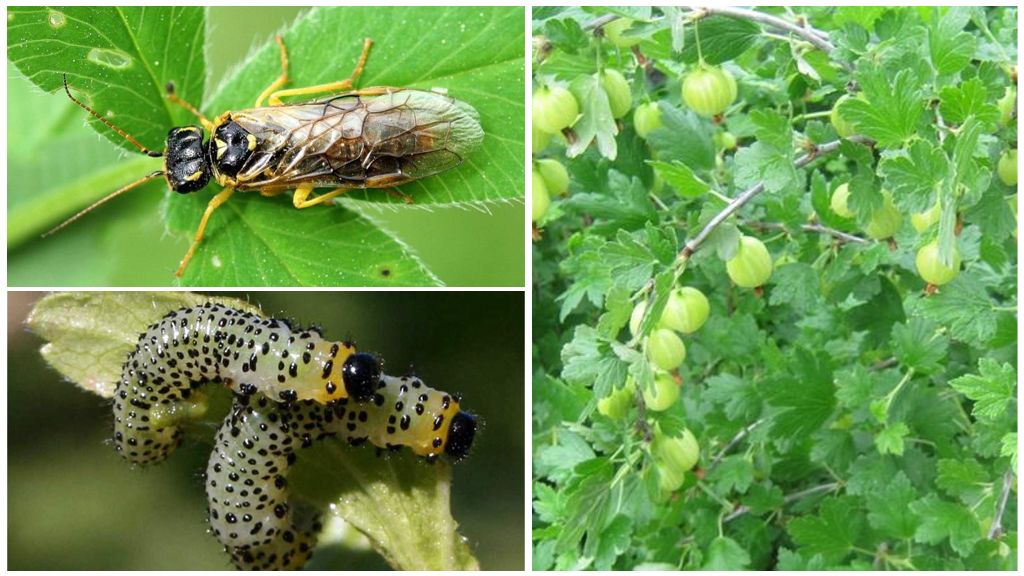
How to deal with a sawfly
To deal with gooseberry caterpillars should be comprehensive:
- In autumn, all the foliage needs to be collected and burned.
- The soil under gooseberry bushes needs to be dug up well. The larvae of insects that went for the winter, as a result of such actions will be destroyed.
- Old branches should be cut.
- It is recommended to mulch the soil.
- In early spring, when the buds have not yet appeared on the bushes, pour on the ground a mixture prepared from two glasses of ash, 1 tbsp. tablespoons dry mustard and black pepper, and cover with a film. In this way, you can get rid of pests.
- The thermal method will also help. As soon as the ground warms up at the roots of gooseberry bushes, you need to process it with boiling water.
- Regularly inspect the bushes for caterpillars. If they have already settled there, the larvae are manually collected and destroyed.
On a note!
It is recommended to plant a tansy between gooseberry bushes or an elderberry next to them. These plants repel insects with their smell. Also, they do not tolerate the aroma of tomatoes, turpentine, diesel fuel and other substances with a pungent odor.
Fire
Gooseberry moth - a dangerous insect that can destroy almost half of the crop. The butterfly is small in size and has front gray wings with brown stripes. The female lays her eggs in unblown buds and ovaries. The caterpillars emerging from them begin to eat flowers.
On a note!
In gooseberries, small caterpillars are also frequent guests. Their favorite food is the core of the fruit, they literally gnaw out everything inside them. As a result, the fruits change in color and dry out.
Caterpillars braid with their web not only foliage, but also berries, peduncles. If the caterpillars eat gooseberries, what to do in this case: use the available methods to destroy them.
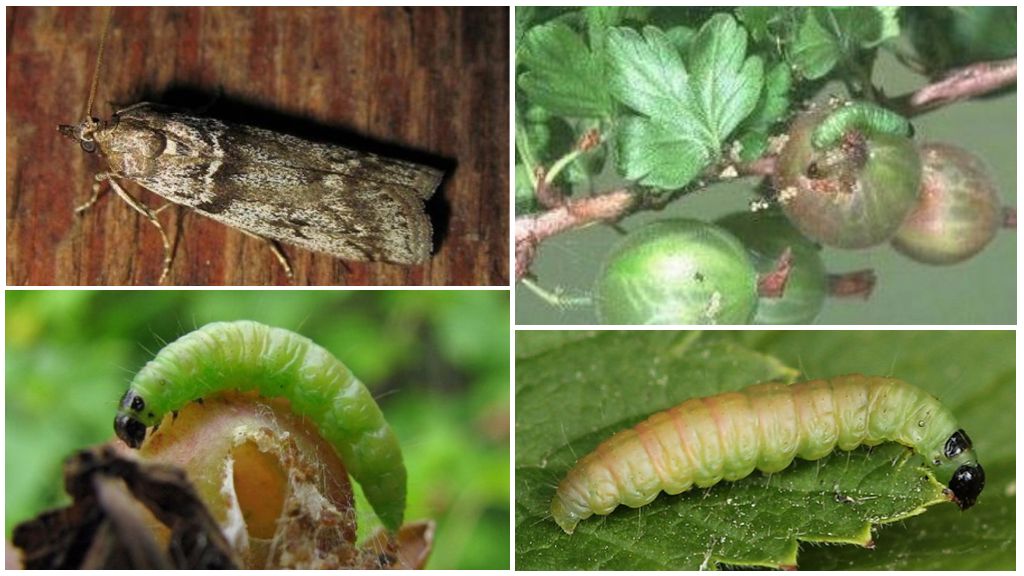
How to deal with a firebox
Agrotechnical methods can be used to destroy fireworm caterpillars. Since the insect spends winter time in the soil directly under the gooseberry bush, it is imperative to regularly dig up the ground. As soon as autumn comes, it is recommended to carry out the hilling up to a depth of 10-12 cm. You also need to take such measures:
- Around or next to plants plant mint, tomatoes.
- A reasonable solution is to attract ground beetles to the site of natural pests. These bugs are happy to eat the larvae of sawflies and fires. To attract them, just put under the bushes roofing felt or roofing material, which serve as a shelter for them.
- When planting gooseberry bushes, it is necessary to leave enough space between them for good air exchange. Do not forget that gooseberries love the sun.
It is good to handle gooseberries from caterpillars with old proven methods. They are as follows:
- Wood ash spray. It is necessary to take it in an amount of 3 kg, sift and pour 10 liters of water. Leave the resulting solution for 48 hours, after which it is filtered and sprayed with gooseberry bushes.
- 12% dust solution. They cultivate the soil near the bushes. After a week, dust (50 g) is scattered in the form of a powder, it will help consolidate the effect.
- Infusion of tomato tops. Every 7 days they should spray gooseberries on the tracks.
- Coniferous branches. You should collect them in an amount of 200 grams, pour two liters of hot water and insist for a week. Before spraying, the mixture is diluted with water, observing a proportion of 1:10.
- Mustard tincture. 100 grams of powder is diluted in a standard bucket of water and insisted for two days. After that, the resulting solution is filtered, diluted in a ratio of 1 to 2 and proceed with the spraying process.
On a note!
As with the track sawfly, it is recommended to manually assemble and destroy.
Shoot aphid
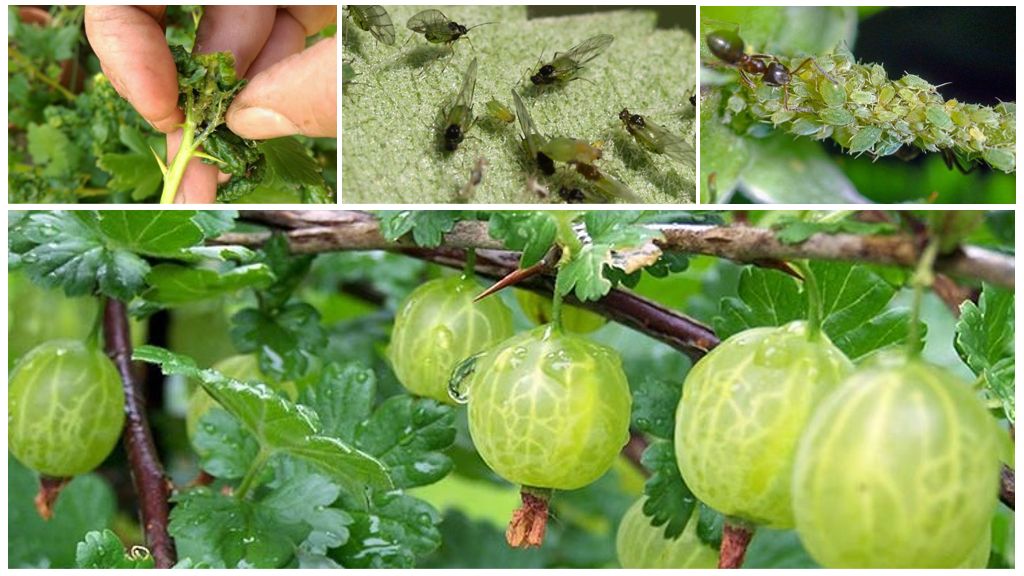
Refers to a common type of pest. Her eggs in the winter remain on the shoots. With the onset of spring, larvae appear that feed on the juice of young leaves. As soon as insects fly out of them, they settle on the top of young shoots, slowing their growth. Deformation of the leaves occurs, as a result, a lump of them forms on the tops. Thus, the aphid creates for itself a "house for life." Gooseberries, affected by aphids, grow poorly, he has late kidneys.
How to deal with aphids
If this type of insect is found on a gooseberry bush, it is recommended to use boiling water and water the plant with it. Well in the fight, such methods help:
- Garlic. It is necessary to grind it in the amount of 300 grams, fill it with 10 liters of water, let it brew a little, strain and process the bushes.
- Onion peel. Insist onion peel (200g) for 5 days, poured with 10 liters of water, then spray the plants.
- Burdock. The leaves are crushed, insisted for 2-3 days and treated with bushes.
Feedback
My gooseberry bushes were hit by aphids. I used garlic. I made a solution, as described above, and sprayed them with bushes. It helps a lot. In the fall under the gooseberries, pour ash.
Olga, Vitebsk
Moth
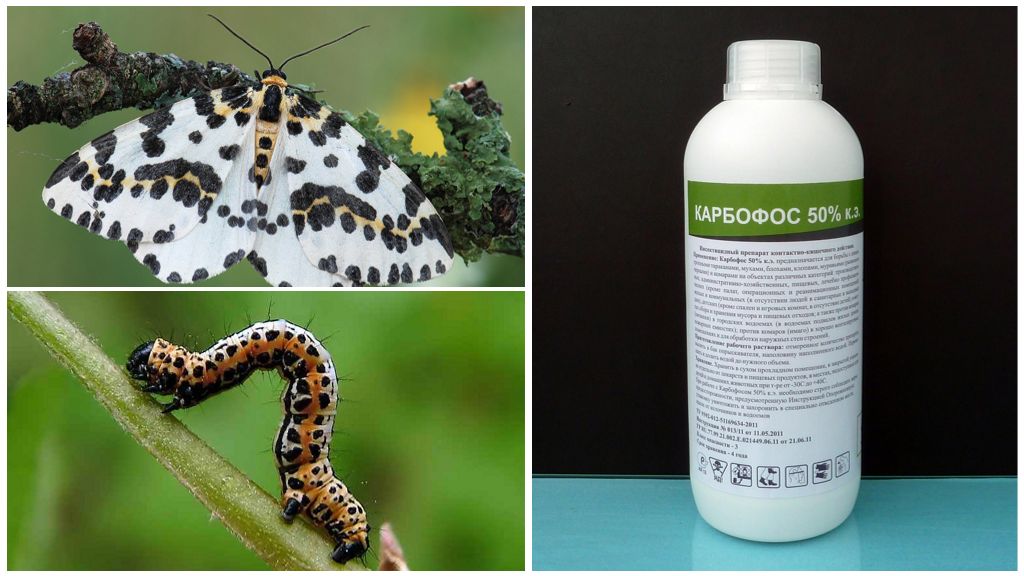
The caterpillars of this insect completely hit the gooseberry foliage. In winter, they spend under fallen leaves, and in the spring they leave cocoons and eat them. On the bush there are only cuttings. After flowering, track development ends, they pupate, are attached by a web to the leaves. After 3-4 weeks, butterflies appear and lay their eggs on the inside of the leaves. New larvae soon emerge from them, and the process repeats, after which they set off to winter.
How to deal with the moth:
- Just as with other representatives of insects, you should remove and burn leaves, dig the soil.
- For processing, decoctions of shag, tinctures of chamomile are used.
- It is recommended to spray them with karbofos 2 times for their destruction. The first time, as soon as they appear on the bushes, the second - 20-30 days before harvesting.
Chemicals
The most effective drugs are insecticides. Processing gooseberry bushes should be carried out 2 times per season. The first time - as soon as the buds open, the second - after flowering. If the larvae appeared after harvest, the spraying procedure must be repeated. To do this, use the following recipes:
- Dissolve 20 g of 50% trichloromethaphos-3 in 10 liters of water. Processing is carried out at the time of opening of the buds and after flowering. If new pests appear, the procedure is repeated.
- A solution of 10% malathion. 75 grams of the composition are dissolved in 10 liters. Processing is carried out during the formation of the buds.
- Ready-made products: Karate, Spark, Fufanon, Decis, Gardona and others. They should be used in early spring until the plant has bloomed.
On a note!
A remedy called Bitoxibacillin has proven itself well. The drug perfectly helps against all types of pests. It is somewhat aggressive, but when used correctly, it perfectly destroys the tracks. It does not harm plants and does not affect yield.
Feedback
I have 5 gooseberry bushes in the country. Tasty, juicy fruits and no pests. But how surprised I was when I noticed the caterpillars after I had already picked the berries. They destroyed leaves with such fury that I was scared. I bought the funds: Commander and Spark. At first I processed one, after 2 weeks the second. Under the bushes poured ash.
Valentina, Izhevsk
Now you know how to get rid of gooseberry caterpillars using affordable methods, without any special financial costs and efforts.
